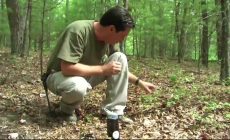Fancy catching your dinner in the Great Outdoors, instead of cracking open a tin of beans? We get you! There’s nothing quite like savoring the fruits, or should we say: meat, of your labor – prepping a self-caught meal on a roaring campfire. However, if you want to feed off nature, you need to know how to catch your food in the wild. That’s exactly why we wanted to recap the Top 5 ways of securing yourself a catch on any outdoor adventures. Granted, some ways sound tastier than others, but all of these will help you get fed!
Get inspired to release your inner hunter-gatherer, and leave those cans of beans and instant meals at home next time you venture out on a camping adventure:
Fishing

Fishing is one of the easiest ways to catch food in the wild. Whether you use a very basic setup of a make-shift rod fashioned from a tree branch with line and a hook or prefer a more skilled way of angling such as a bait caster reel: everyone can fish. That said, if you want to be successful in hooking a winner, it does help to have some basic knowledge and the right gear at hand. That is why, if you are serious about catching your meals, we recommend you prep and pack the essentials. For example, your favorite fishing rod, the best fishing tackle box filled with different lures, baits, and accessories, and a fishing knife/line clippers. Don’t fancy lugging all that gear with you? Then watch some survival videos online, where experts teach you how to make your rods, find live bait, and even carve your hooks with some basic tools. We could share all the instructions on how to make your fishing gear, but truthfully: it’s much better to watch some videos than trying to describe each step with words. Educate yourself, and don’t forget to double-check any fishing regulations that may apply at your angling spot! Some states and National Parks have strict rules about allowance and possession, so make sure to read up on these, before you chuck your catch onto the grill!
Trapping

Trapping (a.k.a. animal trapping) is the method of catching animals using a trap mechanism/device. If you crave protein but are a terrible hunter or archer, trapping could offer an easy, safe solution to catch small game and animals. There are dozens of trapping methods, from basic to highly-elaborate. One of the easiest methods for beginners is the classic Ground Snare: simple, yet very effective. Warning: if you’re a vegetarian or pescetarian, stop reading now. Still there? Great, then we’ll explain briefly how the Ground Snare method of trapping can help you land a tasty dinner! The Ground Snare method requires you to take some paracord, rope or wire, and create a simple snare knot. You then tie one end of the cord to a tree, branch, or other solid objects, and hang the loop of the knot at head height, depending on what type of game animal you’re trapping for. If an animal walks through the loop, the rope/line automatically tightens the further they venture away from the trap: locking them in place for you to collect. Yes, we know it may sound a bit medieval, but the gallows-style setup works a treat if you need food… The Ground Snare is just one of many trap designs you can use, and – if you’re interested – there are lots of tutorials found online.
Hunting

If you want to catch food in the wild, hunting for it is often regarded as the most effective way. Our primal hunting instinct has been with us for millions of years, though some of you may have to rediscover your inner hunter before landing a catch. That said, it’s worth practicing your hunting skills, as it could help you survive off the land on any outdoor adventure. There are dozens of ways to hunt, and hundreds of different types of prey to catch. Each target may require a different approach and hunting gear. For example, if you want to shoot cottontail rabbits, a classic shotgun is the right choice. However, for stalking deer, a quality action rifle is preferred. Or perhaps you want to go turkey hunting, for which a muzzleloader is a great fit. Some recreational hunters may also favor the bow and arrow, however, this method takes a lot of skill and practice before you’ll be able to catch a winner. Our general recommendation is to research the area where you plan to hunt and figure out which animals will be your intended prey. This allows you to pack the right equipment and ammunition and helps you determine a plan of attack. Do note that hunting is subject to many rules and regulations, including the need for permits, in nearly all locations. Always check the local regulations for hunting before you pull the trigger or tension your bow, as you don’t want to end up with a hefty fine instead of a tasty dinner.
Catch Some Bugs
No, we’re not talking about a parasite or bedbugs: we mean creepy crawlies that can sustain you as a food source. Though this option of catching food is not for the squeamish, bugs, grubs and critters can be a great source of protein and energy. If you’ve not managed to trap any animals or shoot prey, then why not consider this alternative method of eating in the wild? Some can even be eaten alive, though we may recommend frying them with some salt and pepper to trick your mind into thinking you’re eating some lovely pork crackling. Do note that you will need a trained eye and some background knowledge to catch bugs as a food source. There are certain insect species you should avoid, as they can be poisonous or cause some serious tummy aches. What bugs and critters can you eat? Well, lots of varieties, including caterpillars, ants, and even scorpions. We recommend doing some research on the topic and learning how to identify different species before you set off on an adventure. That way, you’ll know which creepy crawlies can be turned into a protein-rich feast, and which will make you end up spending the days on a camp toilet.
Foraging
Yes, we know foraging is not ‘catching food’ by definition, but we still wanted to include it on this list. Because foraging is one of the most effective ways to fill your tummy on any outdoor adventure. Whilst many of us tend to focus on hunting, fishing, or trapping to secure a meal, some outdoor enthusiasts swear by foraging as a food source. Fruits, berries, nuts, mushrooms, plants: the Great Outdoors can be your pantry if you know what to look out for. And more importantly: what to avoid. To become a great forager, you need a trained out, basic knowledge, and perhaps a guidebook for reference. Similarly to bugs and grubs, not all plants are edible, and some may even be poisonous. That is why we’d recommend brushing up on your foraging knowledge in between camping trips. Buy some books on the topic, browse some blogs for tips and tricks, and make sure you know what plants are found in the area you plan to explore. Perhaps even write down some pointers that you can use on the trail. Nature can become your very own smorgasbord, allowing you to ‘catch’ a delicious meal, without any of the efforts of fishing, hunting, or trapping.























Leave a Reply
Your email address will not be published. Required fields are marked (required)